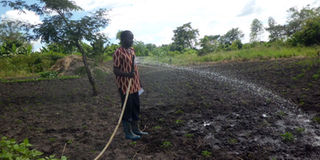Nakaseke farmers doing their bit to keep soils fertile

Crop scientist explains the agronomy of highland maize during the 17th edition of the Seeds of Gold Farm Clinic in Lira recently. Like in Lira, farmers in eastern Uganda will this morning get latest skills in growing maize. Photo by Kelvin Atuhaire
What you need to know:
- The women farmer group comprising of 35 members from Mifunya village led by Ruth Seruwo were able to start with 60 birds and 20 pigs which have grown in number.
- They are able to gather as a group and make snacks such as chapatti and pan cakes. Seruwo says this has improved livelihoods of families in the village because most members.
Amid the increasing threat of global warming climate-smart agriculture is helping Nakaseke farmers in sustainable crop production to enhance their income, writes Lominda Afedraru.
Henry Sebyala a farmer based in Nakaseke is a happy man having tried taxi driving and abandoned it for farming. Before 2012, Sebyala’s income was staggering and he was forced to abandon taxi driving to engage in coffee growing on a four-acre land.
He had saved Shs3.5m from taxi driving which he used to purchase the initial land and later he kept on adding paying each acre at Shs2.5m until he accumulated 13 acres. He has partitioned the land for coffee, oranges and vegetables with a niche of climate smart technology.
This was after experts of Sesakawa Global 2000 came on ground to sensitise farmers to adopt new technologies including climate smart agriculture to increase productivity to better their livelihoods.
Coffee and orange farming
Sebyala is growing coffee on the biggest chunk of the land where he started with the traditional varieties before resorting to the improved varieties which he obtained from the National Coffee Research Institute. He is able to harvest 42 bags of dried coffee every season which he sells for Shs2,200, a kilo. He grows the improved types of oranges especially Valencia on three acres from which his harvest averages nine bags per harvest season.
Climate smart agriculture
Sebyala has apportioned two and half acres to growing assorted vegetables ranging from egg plants, tomatoes, onions and cabbages among others. He describes climate smart agriculture as a system of ensuring there is water facility to enable growing of vegetables throughout the year.
He has a water collection point of 16sq meters and nine feet deep where he harvests rain water.
He is able to practice sprinkle irrigation by using a treadle pump which is connected near the water facility. As one person is concentrating in pumping water through to the connected pipe, someone has to move round the field sprinkling water on the crops.
Sebyala does this mainly during dry season to enable continuous production of the various vegetable varieties.
According to Sebyala, he applies manure which he obtains from chicken and animal droppings which is mixed to the soil. In case the water from the pond dries up, he has to fetch from a nearby borehole facility which he uses for irrigation using water cans but usually the pond is enough to hold water till the next rain season.
He is able to harvest the various vegetables and in a season he gets sale of between Shs1m and Shs1.3m depending on the yield of each vegetable variety.
Sebyala is encouraging other farmers to venture into climate smart agriculture which can be effectively applied in vegetable growing because it is a quick source of income.
The vegetables take at most one month to grow especially for the leafy green vegetables such as Nakatti, cabbages and egg plants.
According to Sebyala from all the farm proceeds combined, he is able to earn Shs7.8m in a season which he is using to improve his family welfare.
Sesakawa’s role
Juliet Nakitende, who is in charge of product evaluation at Sesakawa Global 2000 notes that in 2016 her team reached out to farmers in Nakaseke where they selected farmer leaders and trained them in best agronomy practices, post-harvest handling and storage to avoid post-harvest loses.
Other initiatives were formation of women groups for poultry projects as a group and out of the proceeds, they get they get engaged in making confectionary products from farm products as a group and later they distribute the proceeds. They were trained by qualified agricultural scientists especially in the agronomy aspect and the farmer leaders are now able to train their fellow farmers on best practices right from farming to agro possessing, post-harvest handling and storage
The women farmer group comprising of 35 members from Mifunya village led by Ruth Seruwo were able to start with 60 birds and 20 pigs which have grown in number.
They are able to gather as a group and make snacks such as chapatti and pan cakes. Seruwo says this has improved livelihoods of families in the village because most members.




